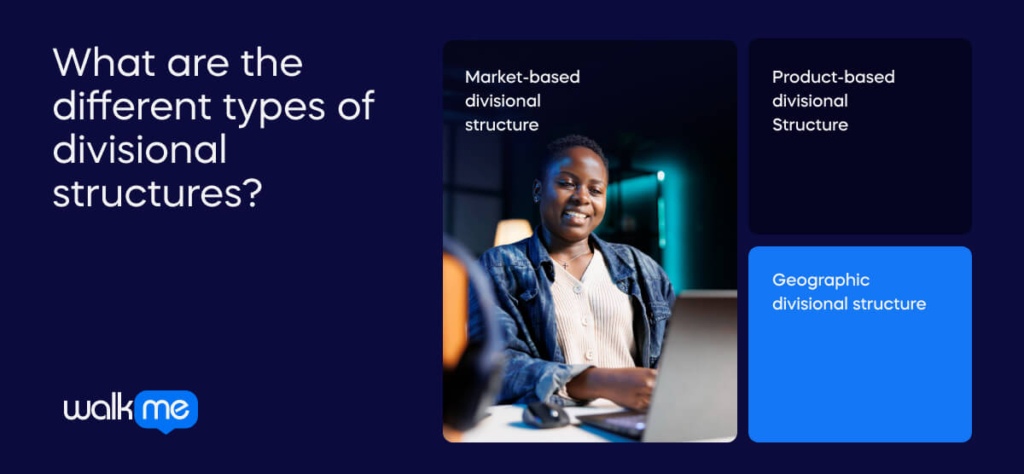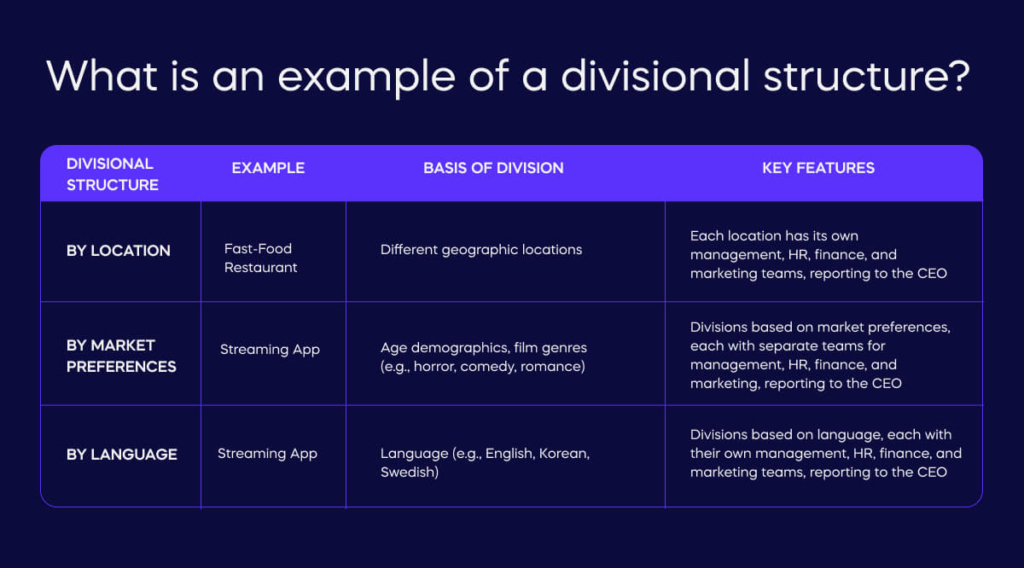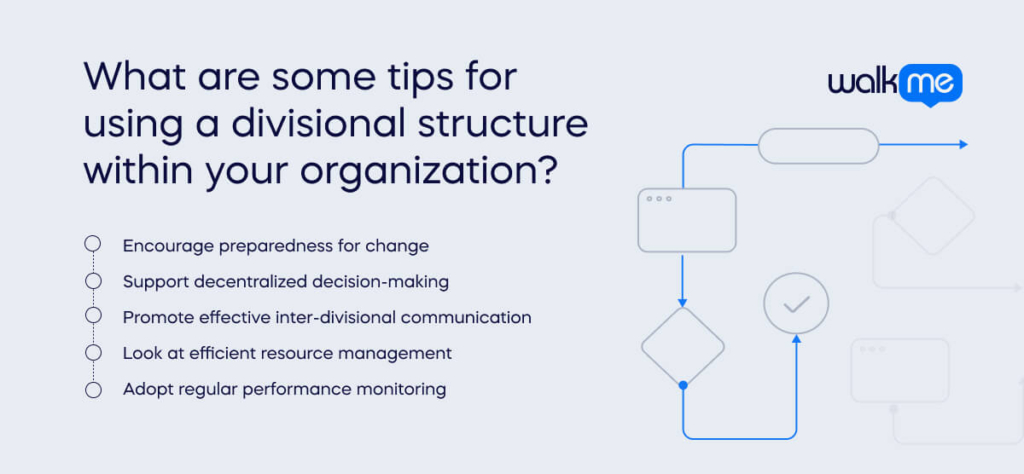When a company grows beyond a single product line or region, managing everything from one central hub often creates bottlenecks. The divisional organizational structure solves this by grouping operations around products, markets, or geographies. Each division controls its own resources, sets priorities, and takes ownership of results, which encourages accountability and faster decision-making.
This autonomy, however, comes with challenges. Divisions risk duplicating efforts or drifting away from the company’s overall direction. That’s why effective change management is essential. Whether introducing new technologies, rebalancing budgets, or shifting strategy, leadership must guide divisions through transitions without stifling their independence.
In this article, we’ll define the divisional structure, explain its variations, and compare it with functional models. You’ll see how companies use it to sharpen focus, the trade-offs it creates, and best practices to implement it successfully.
What is a divisional structure?
You can organize the workforce by products or markets in a divisional structure.
Divisional structures assign teams to specific regions or products instead of having separate departments like marketing or sales. This setup is suitable for bigger corporations, enabling them to divide into autonomous divisions.
The characteristics include selling a wide range of products to customers. These include offering services to both B2C and B2B customers. It also consists of those targeting different demographics in advertising.
A divisional structure could also allow marketing in various geographic areas, allowing you to provide personalized attention to major clients.
How does a divisional structure work?
A divisional structure splits the organization into self-contained units or divisions. This makes each one responsible for its own performance. You can create divisions depending on factors. These include product lines, geographic markets, or customer demographics.
Each division operates independently, with functional units dedicated to divisional goals. This arrangement allows divisions to have expertise in their products or markets.
What are the different types of divisional structures?

Three primary divisional structures exist:
Market-based divisional structure
This divisional structure involves arranging an organization based on industry or customer type. Large consumer goods corporations can adopt this approach. They can then dedicate departments to clothing, electronics, home goods, and food. Categorizing markets is possible. Consider sales channels such as retail, e-commerce, or catalog.
Product-based divisional Structure
Product lines determine the organization of departments in a product-based divisional structure. This structure is useful when products have unique features and require separate marketing and management strategies.
Geographic divisional structure
A geographic divisional structure divides the organization by region, territories, or districts. This helps with localization and logistics. It could also involve companies setting up satellite offices in different regions.
Who should use a divisional structure?
Large organizations would prefer divisional structures. This is because it allows efficient operation and autonomy within each business area. This is particularly beneficial for businesses spread out over different locations. It can also be useful for those offering various core products and services. This structure eliminates conflicting priorities of globally scattered teams.
Moreover, divisional structures enhance agility. They do this by enabling swift adjustments to industry shifts or customer demands. They also foster independence, autonomy, and a tailored approach. This allows large companies to maintain flexibility and adaptability in dynamic markets.
Functional vs divisional structure: What is the difference?
A divisional organization focuses on specific products or markets. A functional organization organizes its operations through business functions. These include marketing, production, and finance. In a functional structure, all departments report to a single coordinating executive. For instance, production activities fall under the production department’s purview.
This system is well-suited for diverse organizations. It is also useful for businesses that want to encourage skill specialization.
However, a divisional structure is suitable for organizations with many product categories. It splits the organization into distinct units or divisions, each with a divisional manager in charge. For instance, an organization has four divisions, each with departments for production, marketing, finance, etc.
What is an example of a divisional structure?

In a divisional structure, companies arrange themselves according to product, market, or location. For instance, a fast-food restaurant might organize itself based on location. However, a streaming app could organize itself according to market preferences. These include age demographics or film genres like horror, comedy, or romance.
Another option is to categorize the streaming app by language. These could include English, Korean, and Swedish. Each division operates with its own management, HR, finance, and marketing teams. All will report to the CEO. Each division functions as a self-contained entity within the larger organization.
What are some tips for using a divisional structure within your organization?

Here are some tips to help you maximize the usage of a divisional structure within your business:
Encourage preparedness for change
The dynamic nature of a divisional structure necessitates organizational preparedness for change. The introduction of new products or markets may need the formation of new divisions. This results in changes in resources and personnel. Adaptability guarantees an efficient reaction to these changes.
Support decentralized decision-making
Granting each division autonomy for decision-making within their expertise fosters ownership and accountability. Senior leadership plays a pivotal role in modeling collaborative behavior within this structure. Visible joint leadership also demonstrates alignment toward common goals.
Promote effective inter-divisional communication
Communication between divisions is essential to aligning individual divisional goals with broader organizational objectives. Regular meetings and discussions can help maintain alignment. It can also foster a shared vision across all divisions.
Look at efficient resource management
Centralizing functions such as HR or IT across divisions prevents resource duplication. This also reduces costs and promotes efficiency.
Adopt regular performance monitoring
Regular performance monitoring is crucial when each division operates on its own. Evaluating performance helps identify divisions that excel and areas that need improvement. Insights inform decision-making and strategy development.
What are the benefits of a divisional structure?

There are several benefits of adopting a divisional structure. These are:
Enhanced focus and alignment
Divisions promote better focus and alignment by setting clear team directions. Transparency and a common mission foster a stronger work ethic among the group.
Optimized core competency
By focusing on their core competency, divisions can optimize every aspect of the product for the ideal market and customer. Teams can customize solutions and offerings to meet customer demands.
Freedom to experiment
Divisions having autonomy enables them to experiment. It also allows them to customize solutions for markets and customers. The use of divisional structures allows for the testing of new ideas and strategies.
Accountability and transparency
Each division has dedicated management groups that lead to clearer accountability. Making it easier to track actions and results allows for better accountability. It also allows a division to acknowledge successful outcomes.
Tailored company culture
Divisional structures allow for the establishment of company culture on an individual level. Divisions also maintain regionalized adherence to overarching company values, promoting cultural alignment.
Efficient decision-making
Dividing the organization into divisions boosts decision-making, problem-solving, and teamwork efficiency. Each segment has dedicated leadership teams. Do this to ensure swift support for objectives and a fast response to team needs.
Agile response to market changes
Divisional structures enable quick responses to market changes. They do this by granting high autonomy and bypassing bureaucracy. Managers can adjust strategies in response to market demands.
Competitive advantage in local markets
Divisional structures give managers the power to make business decisions within their domain. This gives them a competitive advantage in local markets. Customized products and marketing plans can meet the needs of targeted regional consumers.
Product development and support
Specialized teams within the division can dedicate all their efforts to support specific products. This guarantees top-notch quality and focused attention.
Streamlined organizational expansion
The divisional structure’s clear path enables organizational expansion. This could involve incorporating new products or expanding into different markets.
Tailored talent acquisition and retention
HR can focus on customized talent acquisition and retention strategies. This can align with the specific skill sets needed by different divisions in this framework. Engaging in skill development activities helps attract and keep talented individuals.
Simplified performance evaluation
Performance evaluation becomes simpler with the divisions’ semi-autonomous nature. This is because it allows tracking each division’s performance. This assessment helps identify strong and weak performers. It also allows for focused improvement strategies and accountability.
What are the challenges of a divisional structure?

But, it’s also important to be aware of the challenges of a divisional structure:
Silo mentality and lack of cross-functional collaboration
The main aim of the divisional structure is to create team divisions. This can impede innovation, alignment, and communication due to a silo mentality. Businesses that operate in silos can face product inconsistencies and internal conflicts. This means they lose out on the benefits of cross-functional teams.
Inefficient resource allocation and higher operating costs
Compared to divisions, functional structures merge administrative functions. Do this to achieve better resource use and lower costs. Higher operating costs and the need for centralized corporate oversight can lead to higher overhead expenses.
Mitigating higher costs and divisional conflicts
Internalizing senior positions or introducing a commission system can help balance increased expenses. Divisions lacking incentives may hinder collaborative efforts. This can lead to conflicting goals and undermining organizational objectives.
Communication challenges and misalignment
A division’s semi-autonomous nature may focus on individual goals over organizational objectives. Lack of communication and alignment can lead to misalignment and competition.
Hindered knowledge sharing and collaboration
Divisional independence can impede knowledge flow. It can also hinder best practice sharing, limiting shared learning. The absence of communication between divisions can hinder long-term innovation and efficiency.
Difficulties in creating a unified company culture
The presence of diverse divisions can deter the creation of a cohesive company culture. This affects shared values and unity within the organization.
What are the alternatives to a divisional structure?
But, your business can also consider alternative organizational structural models like:
Matrix structure
The matrix structure combines functional and divisional elements. It requires employees to answer to two supervisors. These are one for their functional area and one for their project or product.
This setup encourages cross-disciplinary collaboration and knowledge sharing throughout the organization. However, efficient management and governance are required to address internal conflicts arising from conflicting priorities and accountability problems.
Network structure
The network structure emphasizes open communication and relationships, providing flexibility in resource distribution. It enables employees to collaborate, take initiative, and understand workflows, enhancing organizational agility. However, offsite processes can increase complexity and confuse lines of authority, leading to uncertainty in decision-making power.
Flat structure
In a flat structure, there are minimal layers of management. This promotes employee involvement and trust. Organizing employees by functions cultivates expertise and establishes transparent reporting channels. But, centralized decision-making can lead to delayed responses. It can also result in a neglect of organizational goals. This is because of a departmental focus on individual objectives.
Team-based or agile structure
The team-based or agile structure organizes teams around projects, promoting autonomy and flexibility in resource allocation. By leveraging cross-functional capabilities and adaptability, this approach is effective. Nonetheless, there might be a lack of clarity in decision-making and resource allocation. This could lead to fragmented work practices and inconsistency.
What is the future of a divisional structure?
The divisional organizational structure groups business activities by geography, market, or product. They could also have different customer segments or product lines. Each department includes all essential roles, such as accounting, sales, marketing, engineering, and production.
This method helps decentralize decision-making and respond to local conditions. This is the case with companies with many regions, markets, or product lines. Yet, it could result in increased expenses and create disjointed divisions.
Although the divisional structure has benefits, it also has drawbacks. This emphasizes the need to comprehend its advantages and disadvantages and consider how they can affect business operations.

FAQs
Collaboration platforms and shared analytics dashboards enable cross-division visibility, improving coordination and aligning divisions with overall strategy.
Each division replicates functions—HR, marketing, IT—leading to duplicated resources and higher overhead compared to centralized structures.
When an organization expands product lines, enters new markets, or faces agility challenges, shifting to a divisional model enhances responsiveness and accountability.
Introduce company-wide KPIs, shared incentive schemes, and rotational programs to encourage cross-division cooperation and reduce counterproductive rivalry.

